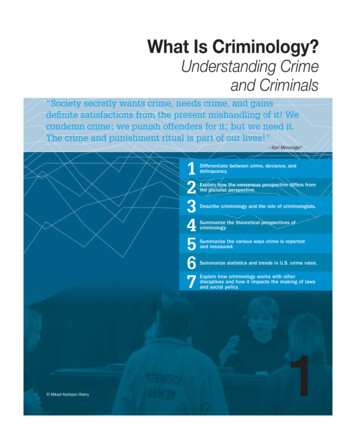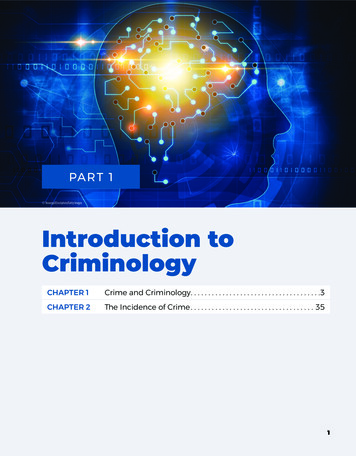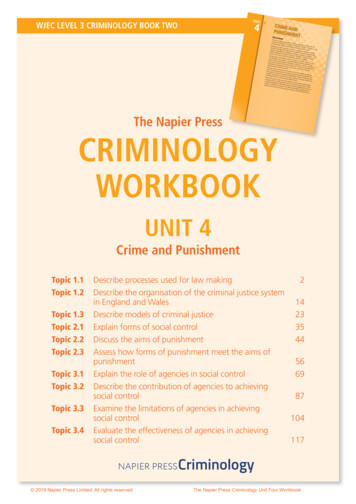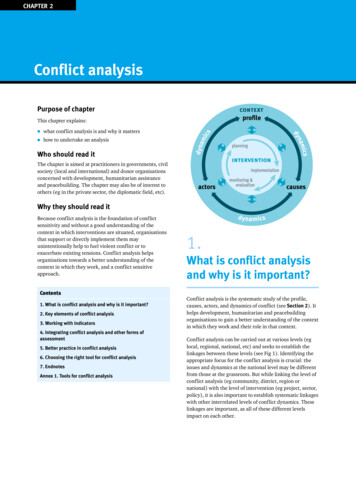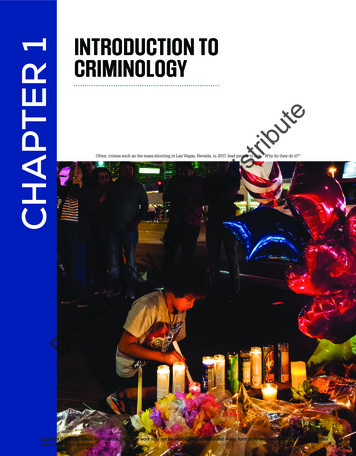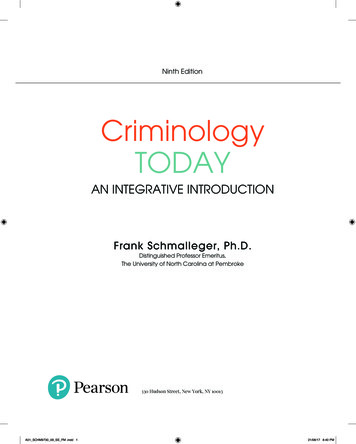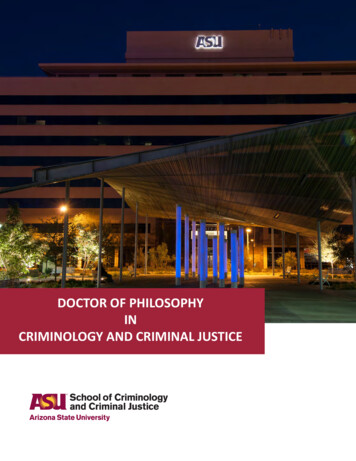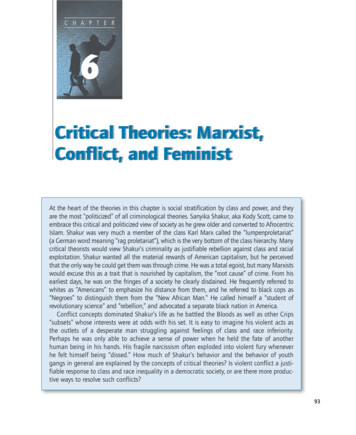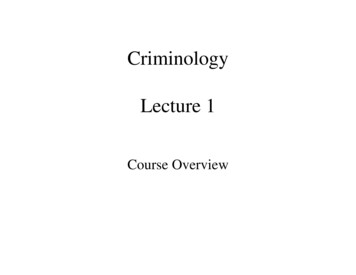
Transcription
CriminologyLecture 1Course Overview
Part I: Crime and Its Definition In this section, we will talk about rules andsystems of social control. We will define “crime” as behavioral actsthat breach rules sanctioned by the state. We will see that there are many other typesof rules, and that the simple legal definitionmay not be adequate.
Human Nature Are humans selfish, prone to breaking rules,and in general prone to criminality? Are humans prosocial, and often willing tofollow social rules, and punish those whodo not? We will look at some experimentalevidence to address these interesting andimportant questions.
Law and Crime Why is watching (and not reporting) a womangetting stabbed and raped not a crime? Why did John Hinckley Jr. only go to a mentalhospital for an attempted presidentialassassination? We will look at how the American Criminaljustice system defines crime
Part II: Nature, Measurement,and Distribution of Crime Measuring Crime (Uniform Crime Reports, NationalCrime Victimization Surveys, self-report surveys) Types of Crime (Property and Violent Crime,Extremism/Terrorism) Patterns associated with crime (age, gender, crime ratesin through time and in different places)
The Age-Crime CurveAge-CrimeArrest Rate per 100,000250020001500ViolentProperty1000500010 12 14 16 18 20 22 24 26 28AgeChapter 3 - 21
Crime: International Perspectives High rates of crime in the U.S. What factors associated with the UnitedStates that might cause high crime rates?(culture, capitalistic economies, inequality,self-concepts) ?
7Columbia56.31.466.957.9Crime Rate in Selected Countries, 1998: Interpol Data (Incidents per100,000)
City:Rate:Rank:Long Beach, CA9,13150New York, NY9,23648Kansas City, MO13,1988Los Angeles, CA9,73040Virginia Beach, VA5,86375Chicago, ILNANACharlotte, NC12,64311Houston, TX10,82429Tucson, AZ10,40133Philadelphia, PA6,83571Albuquerque, NM10,28434San Diego, CA8,53757Atlanta, GA18,9531Dallas, TX15,0666St. Louis, MO16,0315Sacramento, CA10,09837Fresno, CA12,03117Tulsa, OK8,88754Oakland, CA12,18616Honolulu CDP, HI5,95974Phoenix, AZDetroit, MI9,95812,2633814San Antonio, TX12,29113San Jose, CA5,36476Indianapolis, IN7,35767Miami, FL18,3942San Francisco, CA9,38446Pittsburgh, PA8,21958Baltimore, MD11,37119Cincinnati, OH9,72241Jacksonville, FL10,59131Minneapolis, MN11,28222
Regional Crime PatternsPerc en tile M apH om icid e R ate (E BS )199 0NStates 1%1-10 %10 -5 0%50 -9 0%90 -9 9% 99 %WES020 0M iles
Temporal Patterns
America’s Plunging Crime Rate.
Race/Ethnicity and Crime African Americans,Latinos, and otherminorities experiencehigh offender and victimrates.Is it a real Disparity or isit Discrimination?
Questions Why do over 50% of homicidesoccur between family membersand acquaintances? Are most robberies planned andrational? What do criminologists knowabout the causes of terrorism?
Part III: Theory: EvaluatingTheories on Four Criteria1)2)3)4)Assumptions of human natureFactors that cause crimeEmpirical supportImplications for public policy
Deterrence Hypothesis Hypothesis: When thecertainty, severity, andcelerity of criminalsanctions are high in apopulation, criminalbehavior will be low.
Questions Do criminal sanctions deter murderers? Are bigger males more likely to becriminals? Can we blame American crime on the“American Dream” ? Does capitalism cause crime?
Part IV: Controlling Crime:Criminal Justice Institutions andPolicy Informal institutions – Non-state institutions(vigilante organizations, “cultures ofhonor”) Political ideology (conservative and liberal) Guns, drugs
Informal Institutions of SocialControl
Outcomes of Incarceration Policy Rehabilitation orPunishment? Three strikes andyou are out!!
Costs and Benefits ofIncarceration 6% of offenders commit about half of thetotal crimes committed each year. RAND institute: Reduce crime by 28% bylocking up chronic offenders; Cost: 16,000 for every crime Does this work?
Questions Do “three strikes laws” deter criminalbehavior? Should we decriminalize drug use? What is the purpose (and effectiveness) ofdeclaring war on crime?
Introduction to Concepts in theField of CriminologyPart I: The Field of CriminologyPart II: What is a Crime?Part III: How do criminologists viewcrime?
Part I: The Field of CriminologyWhat is Criminology? Criminology is the scientific approach tothe study of criminal behavior. Criminology is an interdisciplinary field.Although criminology’s 20th centuryorientation has been sociological, today itcan be viewed as integrated approach (e.g.biology, psychology, history, economics)
Brief History of CriminologyMiddle Ages (1200-1600) – superstition andfear of devil dominated thinkingClassical Criminology – mid-18th century Rational approach and free willRelate punishment to crimePositivism – 19th century Behavior as a result of many forcesFirst scientific approach to crimeBiological determinismCrime and Criminology3
History of Criminology (cont)Sociological Criminology – 20th century Impact of environment on socialdevelopment and behaviorCrime is a failure of socializationConflict Criminology – late 20th century Relates economics to crimeNow behavior is a result of manyfactors that interact with environmentCrime and Criminology4
Criminology and CriminalJustice Criminology – explains the origin, extent, natureof crime in society Criminal Justice – evaluates agencies of socialcontrol that deal with criminal offenders (andvictims) Theses are related topics that should be consideredtogether (we will cover both).
Criminology and Delinquency Delinquency generally refers to “deviance” amongyoung offenders (e.g. 18 years of age) Juveniles receive different treatment under theAmerican criminal justice system The study of the nature of younger and olderoffenders have used similar theories. Thus, thestudy of criminology and delinquency are oftenvery similar.
Part II: What is Crime?A Crime is a Violation of a LegalRuleTo understand the difference between legalrules and other types of rules we need todefine systems of social control.
Systems of Social Control Rules: definitions of behavior that shouldbe followed Sanctions: rewards and punishments Actors (enforcers)
Categorizing Rules by the Typeof Actors that Enforce ThemLaws: Rules sanctioned by the StateSocietal norms: Rules sanctioned bycommunities or citizens themselves who donot hold formal positions in the legal system
Example of Laws Homicide, Rape, Robbery Embezzlement, Theft Many behaviors violate our morals (e.g., notsaving a drowning person) but are not violationsof laws
Examples of Societal Rules(Norms) ATM lines Bathroom norms Eating etiquette
Problems with Legal Definitionof Crime1.) Laws vary in different places and times. Ifthe law does not exist, is a behavior still acrime?2.) Should deviant behavior (violating norms)be included to understand the nature ofcrime?
Criminology and Deviance Deviant Behavior – behaviorthat departs from socialnorms Criminal Behavior behavior that departs fromlegal rules, or LAWS Complex relationshipsbetween deviance and crime.
How is deviance defined? Conflict perspective. The norms of societyreflect the interests of the rich andpowerful—deviant labels are applied topeople who interfere with the operation ofcapitalism.– Behaviors that threaten capitalist operations aremore likely to be considered deviant
Part III: How Do CriminologistsView Crime?Different assumptions about howlaws emerge
Criminalization: How LawsEmerge The process whereby criminal law isselectively applied to social behavior. Process involves 1.) enactment oflegislation that outlaws certain types ofbehavior, 2.) monitoring and policing ofthat behavior, and 3.) if detected, thepunishment of that behavior.
What Forces Influence theGeneration of Laws? Loss and Harm: People loose property or are injured. Power and Interests: Controlling some types ofbehavior can benefit some parts of society but notothers. Imposition of Morals: Controlling Some Types ofBehavior can Improve Social Life
Forces Believed to Generate LawsInfluence Perspectives on Crime Loss and Harm: rules emerge byconsensus Power and Interests: rules emerge byconflict (the powerful impose rules toprotect their interests). Morals and Common Good: rules createdby “moral crusaders” (e.g., laws againstpornography, prostitution, drugs)?
the study of criminal behavior. Criminology is an interdisciplinary field. Although criminology's 20th century orientation has been sociological, today it can be viewed as integrated approach (e.g. biology, psychology, history, economics)
